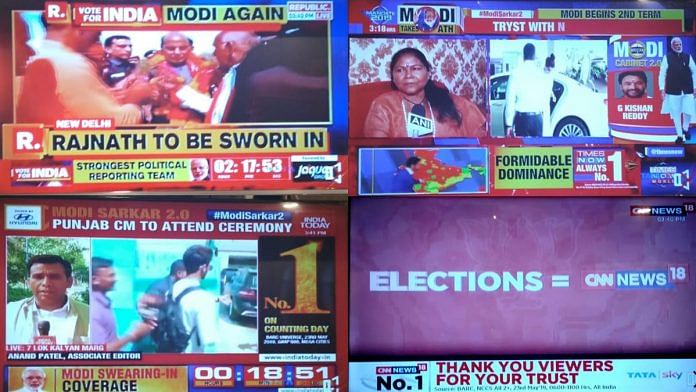New Delhi: Four English news TV channels — Times Now, India Today, Republic TV and CNN-News18 — have claimed they had the highest viewership in the week the Lok Sabha election results were announced.
The odd part is, none of them was wrong — technically. Each of them simply focused on different slices of the same data pie.
The Broadcast Audience Research Council (BARC), the industry body that measures TV audiences, bases its estimates on different parameters: Population strata, further divided by households and individuals, urban and rural areas, gender, seven age groups, and consumers’ financial position.
According to the overall, countrywide TV news viewership data for election week (week 21 of 2019, 18-24 May), Republic TV was the most-viewed channel, followed by Times Now, DD India, India Today and CNN-News18.
However, if viewership is just gauged by the six mega cities BARC factors in, India Today emerges as the most-viewed channel, both on counting day (23 May) and during the counting week. Times Now and Republic take the next two ranks.
So, when India Today claimed to be the most viewed channel, it quoted data for mega cities alone (Mumbai, Delhi, Kolkata, Bengaluru, Chennai and Hyderabad).
Meanwhile, Times Now focused on the age group of 22-50 years among urban viewers, while CNN-News18 based its claim on the 6 am-11 am window.
Also read: 2019 Lok Sabha polls couldn’t have been fairer as far as Election Commission is concerned
‘Not incorrect per se’
BARC data is released every Thursday, and every week the channels make similar claims of popularity.
Multiple industry sources told ThePrint that while the claims can be seen as manipulative, they are not incorrect per se, as they are based on BARC data at the end of the day.
“The data slicing, of course, was different for different channels to bolster their claim of being number 1 in terms of viewership,” said a source.
“The channels have to compulsorily mention what data segment they are citing to make a claim,” the source added.
While the channels do mention the source in fine print, an average television viewer may hardly be able to understand the jargon.
For example, one channel cited the source of its election leadership claims as “BARC, NCCS All 2+, 23rd May, 19 0600-1100 hours, All India”, which means data for 23 May 2019, between 6am and 11am, for all age groups over two years from the entire country.
Another industry source said the claims were made purely for the viewer’s benefit, and didn’t carry weight with advertisers.
“The advertisers have access to detailed BARC data, so it doesn’t help in advertising,” the source said.
A third source said “slicing will be done by all”.
“The core audience of English news for advertisers is mega cities and not rural markets… The performance (in these areas) matters. Slicing will be done by all, ultimately the advertiser has to look at the slice he wants,” the insider added.
Also read: Months before elections, Modi govt gave awards to dozens who pushed its pet schemes
What channels have to say
Vikas Khanchandani, group CEO of Republic TV, said channels of the network were among “the most-trusted news platforms that enjoy huge patronage”.
“We built a massive news studio exclusively for election programming with phenomenal use of the latest technology amplified by Augmented Reality,” Khanchandani said.
“Republic TV was leading on broadcast and was the No. 1 channel during the election week,” he added. “The data source for broadcast is BARC and there was no slicing by specific markets, time bands or target groups.”
While BARC was the source of Republic TV’s claims, it did not state as much in the ads proclaiming its leadership.
Speaking to ThePrint, the Times Network spokesperson said they had used BARC data for the 22-50 (years) age group from Indian cities with a population of over 10 lakh (All India 1mn+) and six mega cities, but justified the practice.
“The parameters selected by us are broad-based and well accepted in the industry and by advertisers at large… This parameter has been used by Times Now to establish leadership for the channel over long periods even before elections,” the spokesperson added in an email. “Hence, there was no slicing or dicing of the data to our advantage.”
A Network 18 representative said the channel’s claims were based on the window between 6 am and 11 am on 23 May, “the main time-band when the overall result was decided”.
India Today did not respond to ThePrint’s queries. This report will be updated when they respond.
Reached for comment, a BARC spokesperson said violations of its “guidelines for the fair and permissible usage of BARC India ratings for claiming leadership” fell under the purview of the Advertising Standards Council of India (ASCI), a self-regulatory organisation of the ad industry.
ASCI secretary general Shweta Purandare told ThePrint that the body “periodically receives… intra-industry complaints over leadership claims of channels and looks into it”.
“Most of these complaints are against competitors and deal with leadership claims over allegedly selective slicing and dicing of BARC data,” she added.
“Whatever complaints are found to be in violation of BARC guidelines, which lay down parameters for reading the data, are upheld and the concerned advertiser is informed… The advertiser channel then provides an assurance of compliance,” she said.
According to her, the ASCI had received several such complaints in the last couple of weeks. “It is for TV channels’ own benefit,” she said. “That the correct data segment is used to make leadership claims.”






